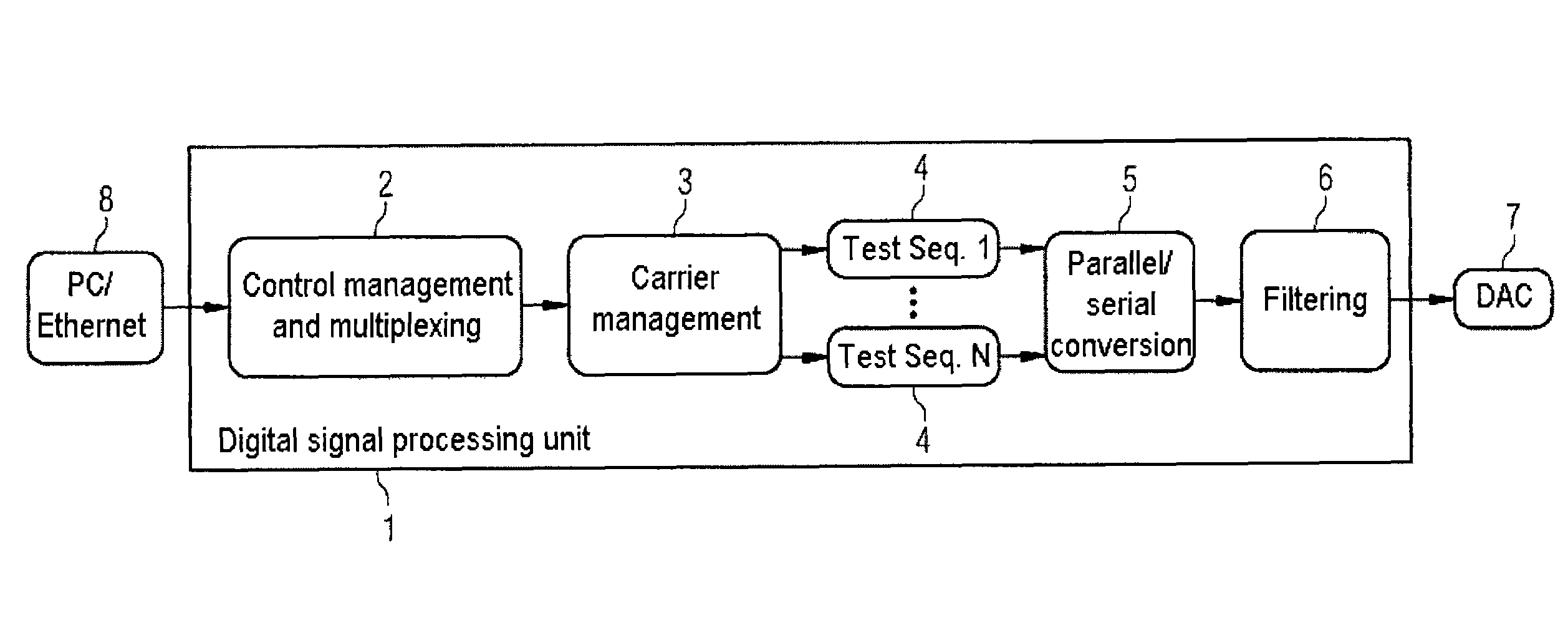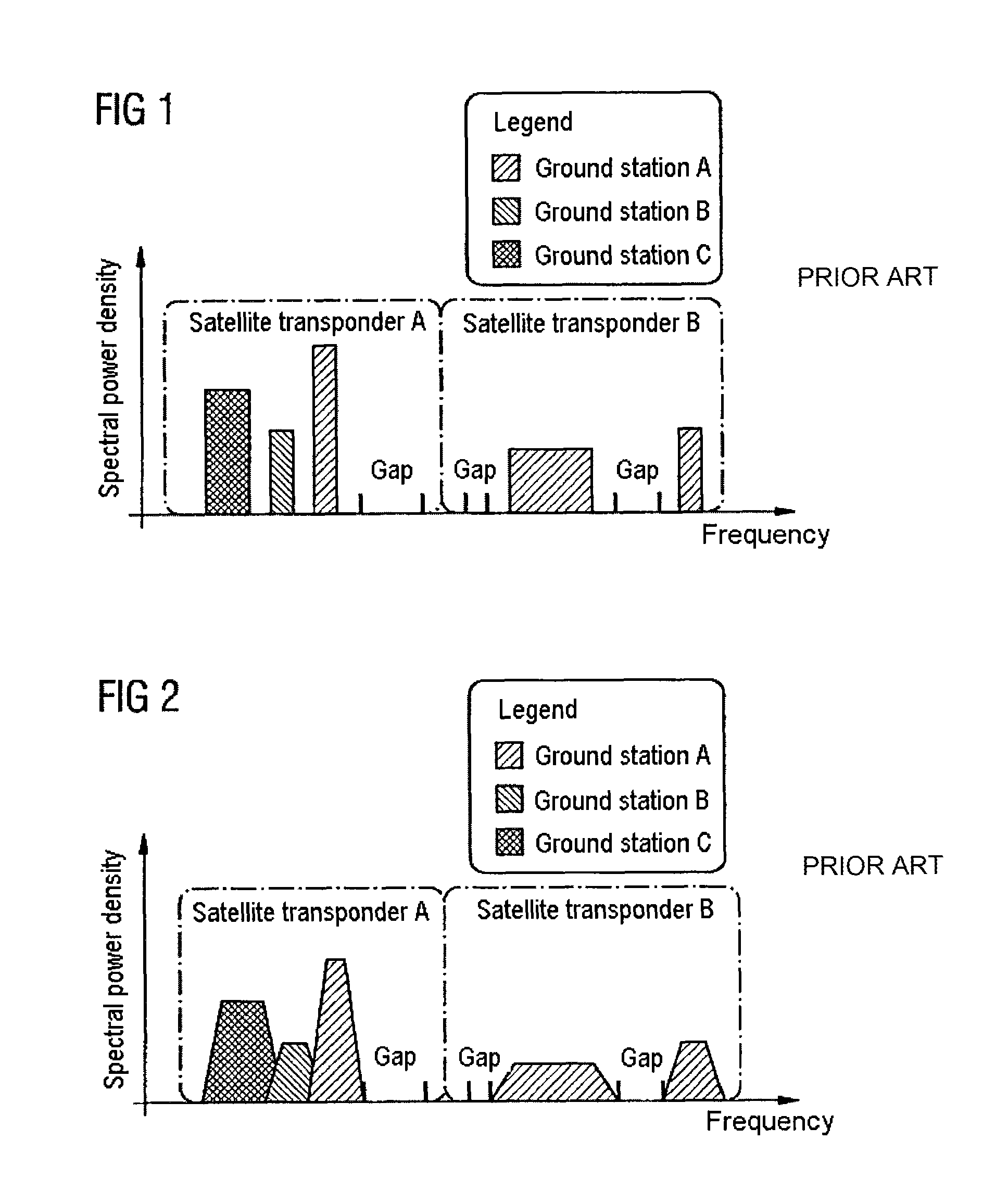Apart from the costs for the measurements which, as a rule, is a service of third parties, this mainly results in losses of turnover since no fees can be charged for rented
satellite capacity for the duration of the measurements.
IOTs are thus necessary and unavoidable because they serve to establish the bearer of the economic load of unfulfilled SLAB.
This spectrum fragmentation represents a great challenge to satellite and teleport operators because unused spectrum in conjunction with existing power reserves of the same
transponder is equivalent to
gain losses which must be minimized.
This becomes economically fatal if the sum of the free positions / gaps in the spectrum and the transmitting power of the satellite in principle still provide for communication services but this is not possible due to the fragmentation of the spectrum.
Physical, that is to say technical and production-related interference mechanisms in the analog components lead to the transmitted and received
signal, respectively, experiencing a multiplicity of the most varied types of signal distortions, caused, for example, by
phase noise, DC component,
frequency offset, nonlinearities,
jitter and I-Q
asymmetry.
In principle, such disturbances always arise where analog modules are used.
In this context, each stage leads unavoidably to a more or less strong linear and / or nonlinear signal
distortion.
In comparison with the other two sources (transmitting
ground station and satellite), however, these distortions can be considered to be significantly smaller and can be neglected in most cases.
A further problem is represented by the so-called ASI (adjacent satellite interference).
ASI is a result of inadequate antenna gains (beam focusing of the antennas) and, respectively, inadequate
gain decoupling of the antennas from the point of view of the
receiver (spatial separation of the signals).
ASI leads to it not being possible to arbitrarily increase the transmitting power on the ground and at the satellite output without disturbing third-party satellites or third-party ground stations.
It is easily understandable that both signal distortions can be mapped directly onto the achievable
data rate because the associated disturbances reduce the ratio of useful signal power and interference signal power at the respective
receiver.
At the moment, the current performance of IOTs is a very long-winded and time-consuming process.
This is mainly due to the fact that the
test equipment currently available on the market is not capable of performing effective wide-band tests.
This, however, conflicts with the measurements having to be performed with high accuracy, that is to say with a high C / N (Carrier to
Noise) or SNR (signal-to-
noise-ratio).
In addition, the desired aim of such measurements at the same time with the useful
data traffic in the transponder could obviously not be achieved by this means.
Naturally, this produces a long
test phase which is equivalent to a
downtime of the satellite and thus entails the corresponding economic consequences.
Apart from the obvious economic disadvantages, contradictory or poorly comparable measurement results can also be increasingly expected with this approach which arise plainly from the change in timing of the
transmission channel during the measurements (e.g. weather influences).
These results are not wrong but distort the view and do not reproduce the momentary characteristics of the overall
system.
For this purpose, separate technical devices must be kept available which are associated with considerable investment costs.
This is extremely uneconomical for the predominant number of operators of teleports and of communication links which is why IOTs are offered today only by a few service providers with great market power.
In addition, separate technical devices must be kept available also for this measuring method which, today, are also associated with very high investment costs.
Feeding the test signal into the existing transmitting and receiving paths of the useful signals is often particularly expensive in this context because, apart from the technical expenditure, additional problems of calibration are added.
In order to separate the actual effects of the satellite from possible influences of these ground-based signal paths, further measurements must be performed at the ground stations which will also lead to constructional and technical changes.
For many operators, this, too, is uneconomical which is why they prefer the service again.
The current ground-based communication technology does not allow any inherent
parallel processing of several channels.
Here, too, it can be easily appreciated that the method described has several disadvantages at once:Increased total weight of the ground stations (each individual modem contributes to this), problematic especially in mobile or transportable useIncreased
power consumption in operation (each modem consumes current and must be cooled additionally), problematic especially in mobile or transportable useThe
ground station must always be designed for the worst case, i.e. for the data streams to be transmitted simultaneously at a maximum in the boundary case.
This is not the most economic solution since the contribution of the modems to the
total price increases linearly with a number of data streams.Synchronization problems (the functionality of the modems must be matched to one another, high technological expenditure; such a solution on the
physical layer, i.e. before / after the DA / AD conversion, has not been known hitherto which is why the distribution of the information at a higher protocol layer (IP level) is being resorted to today)Increased susceptibility to interference (a discrete implementation is more susceptible to mechanical influences due to its structure)
If the technical changes discussed have to be performed and this cannot be done remotely, this often involves high costs for the operator of the communication links since, in most cases, he is not on site with his own personnel and thus has to commission subcontractors.
To this is added that the approach of replanning is extremely inflexible because it is only when it is really necessary that such a large incision is made in all existing communication links.
However, this also means that ad-hoc or short-term enquiries for more spectrum are associated with high financial expenditure.
The operator of the
system will often even reject short-term enquiries for new spectrum since the achievable additional income will not cover the costs for replanning all existing connections, also called line-up.
Analog interferers will result in a limitation of capacity in the
processing of data streams.
At the same time, it was found that, caused by nonlinear components, the maximum
data rate of various links is limited significantly by
intermodulation-related degradations of the
signal quality.
Furthermore, elaborate methods for optimizing the carrier occupancy under
intermodulation disturbances must be used, the
degrees of freedom in the occupancy and combinations of narrow or weak carriers per transponder being distinctly restricted.
In this case, geographic or frequency-related decoupling of the coverage areas and limitations of the permitted transmitting power are used.
However, both of these lead directly to the bandwidth efficiency / SNR being significantly reduced and thus also the achievable
data rate.
 Login to View More
Login to View More  Login to View More
Login to View More 


